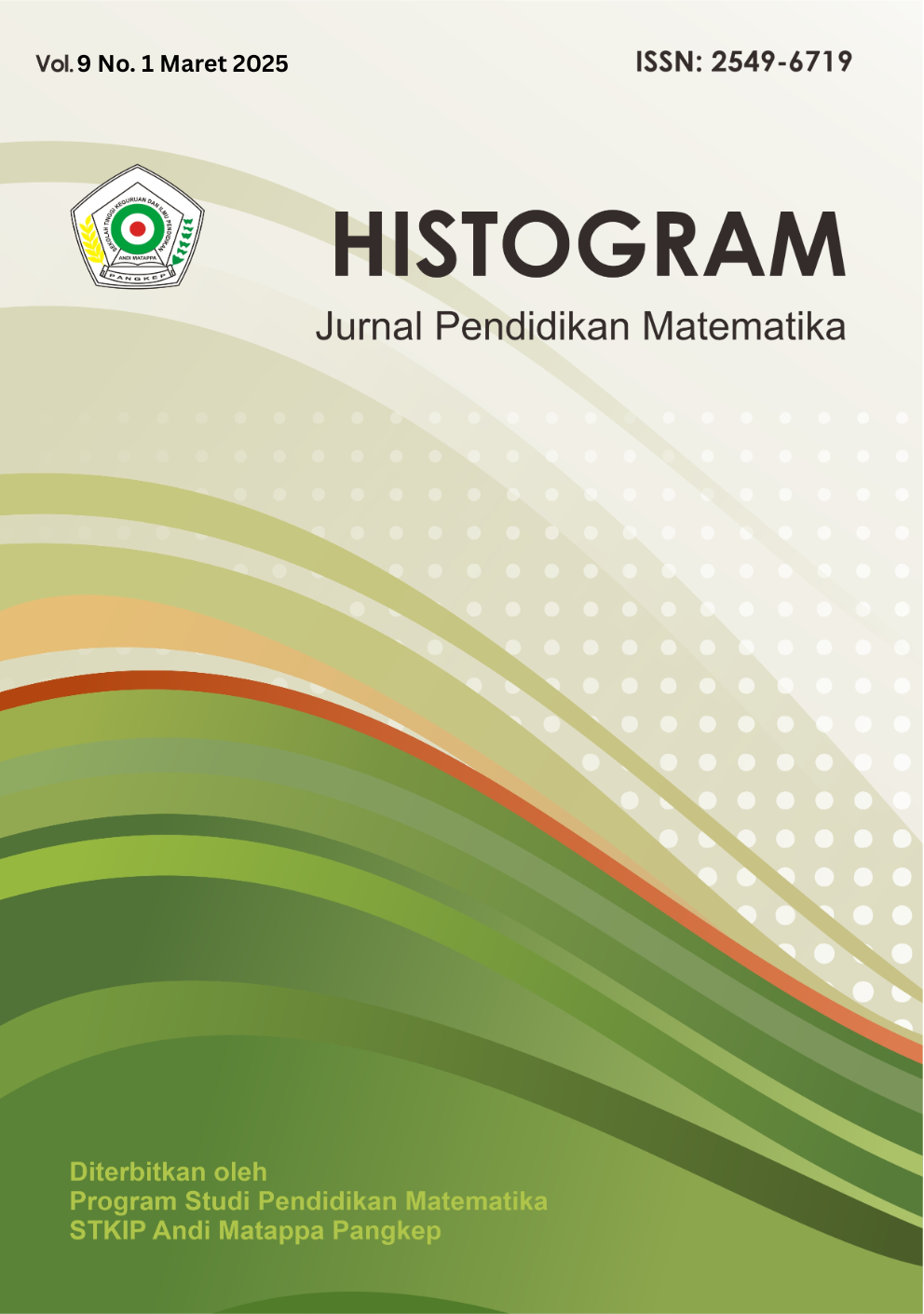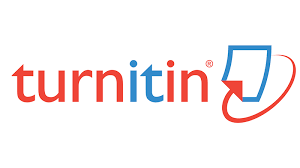ANALISIS PENALARAN MATEMATIS SISWA BERDASARKAN GAYA BELAJAR VISUAL, AUDITORI, DAN KINESTETIK (V-A-K)
DOI:
https://doi.org/10.31100/histogram.v9i1.4106Abstract
ABSTRAK
Penelitian ini bertujuan untuk menganalisis penalaran matematis siswa berdasarkan gaya belajar Visual, Auditorial, dan Kinestetik (V-A-K) pada materi Persamaan Linear Satu Variabel (PLSV). Penelitian dilakukan secara kualitatif dengan pendekatan fenomenologi terhadap tiga siswa kelas VIII di salah satu SMP Negeri Kabupaten Bandung dengan gaya belajar yang berbeda. Data diperoleh melalui angket gaya belajar, tes penalaran matematis, dan wawancara semi terstruktur. Hasil penelitian menunjukkan: 1) siswa dengan gaya belajar visual menunjukkan penalaran matematis terbaik dengan memenuhi semua indikator penelitian, yaitu menyajikan pernyataan matematis, mengajukan dugaan, melakukan manipulasi matematis, menyusun bukti serta memberikan argumen untuk mendukung kebenaran solusi, menarik kesimpulan dari pernyataan yang ada, dan memeriksa keabsahan jawaban atau argumen, 2) siswa dengan gaya belajar auditorial memenuhi empat dari enam indikator, yaitu menyajikan pernyataan matematis, mengajukan dugaan, melakukan manipulasi matematis, dan menarik kesimpulan dari pernyataan yang ada, namun belum memenuhi indikator menyusun bukti serta memberikan argumen untuk mendukung kebenaran solusi dan memeriksa keabsahan jawaban atau argumen, dan 3) siswa dengan gaya belajar kinestetik hanya memenuhi dua dari enam indikator, yaitu menyusun bukti dan menarik kesimpulan. Penelitian ini mengindikasikan bahwa gaya belajar memengaruhi penalaran matematis siswa, dengan gaya belajar visual dan auditorial lebih unggul dibandingkan gaya belajar kinestetik, khususnya pada materi PLSV.
ABSTRACT
This study aims to analyze students’ mathematical reasoning based on Visual, Auditory, and Kinesthetic (V-A-K) learning styles in solving Linear Equations in One Variable. The study employed a qualitative design with a phenomenological approach, involving three eighth-grade students from a state junior high school in Bandung Regency with different learning styles. Data were collected through a learning style questionnaire, a mathematical reasoning test, and semi-structured interviews. The results showed that: 1) students with visual learning styles demonstrated the strongest mathematical reasoning by fulfilling all research indicators, namely presenting mathematical statements, proposing conjectures, performing mathematical manipulations, constructing proofs and providing arguments to justify the solution, drawing conclusions from existing statements, and verifying the validity of answers or arguments, 2) students with auditory learning styles fulfilled four out of six indicators, namely presenting mathematical statements, proposing conjectures, performing mathematical manipulations, and drawing conclusions, but did not meet the indicators of constructing proofs and verifying solutions, and 3) students with kinesthetic learning styles only met two of the six indicators, namely constructing proofs and drawing conclusions. This study indicates that learning styles influence students’ mathematical reasoning, with visual and auditory styles showing stronger performance than kinesthetic styles, particularly in solving Linear Equations in One Variable.
References
Afif, A. M., Suyitno, H., & Wardono, W. (2017). Analisis Kemampuan Penalaran Matematis Ditinjau dari Gaya Belajar Siswa dalam Problem Based Learning (PBL). PRISMA, Prosiding Seminar Nasional Matematika. 328-336.
Asmaliyah, F., Sripatmi, Salsabila, N. H., & Arjudin. (2023). Kesalahan Menyelesaikan Soal Cerita Bentuk Aljabar Ditinjau dari Gaya Belajar. Journal of Classroom Action Research, 2, 48–58. https://doi.org/10.29303/jcar.v5i2.2937
Aziz, J. A., Juniati, D., & Wijayanti, P. (2020). Students’ Reasoning with Logical Mathematical and Visual Spatial Intelligence in Geometry Problem Solving. International Joint Conference on Science and Engineering (IJCSE 2020). 203-207. Atlantis Press. https://doi.org/10.2991/aer.k.201124.038
Cahyani, N. D., & Sritresna, T. (2023). Kemampuan Penalaran Matematis Siswa dalam Menyelesaikan Soal Cerita. Jurnal Inovasi Pembelajaran Matematika: PowerMathEdu (PME), 2(01), 103–112.
Daliah, L. (2019). Local Instruction Theory Materi Lingkaran dalam Pembelajaran Berbasis Masalah untuk Mengembangkan Kemampuan Penalaran Matematis Siswa SMP. Universitas Pendidikan Indonesia.
Departemen Pendidikan Nasional. (2002). Kurikulum Berbasis Kompetensi: Standar Kompetensi Mata Pelajaran Matematika Sekolah Menengah Pertama dan Madrasah Tsanawiyah. Depdiknas. http://repositori.kemendikdasmen.go.id/id/eprint/2983
Departemen Pendidikan Nasional. (2004). Peraturan Direktur Jenderal Pendidikan Dasar dan Menengah Nomor 506/C/Kep/PP/2004 tentang Pedoman Pelaksanaan Pembelajaran Berbasis Kompetensi di Sekolah Menengah Pertama. Depdiknas.
Fiantika, F. R., Wasil, M., Jumiyati, S., Honesti, L., Wahyuni, S., Mouw, E., Maharani, A., Ambarwati, K., Noflidaputri, R., Nuryami, & Waris, L. (2022). Metodologi Penelitian Kualitatif (M. H. Yuliatri Novita, Ed.). PT Global Eksekutif Teknologi.
Hayes, J., & Allinson, C. W. (1994). Cognitive Style and Its Relevance for Management Practice. British Journal of Management, 5(1), 53–71. https://doi.org/10.1111/j.1467-8551.1994.tb00068.x
Jannah, A. R., & Marlina, R. (2023). Analisis Kemampuan Penalaran Matematis Ditinjau dari Gaya Belajar Siswa SMP. Jurnal Didactical Mathematics, 5(2). 104-113. https://ejournal.unma.ac.id/index.php/dm
Loong, E., Vale, C., Widjaja, W., Herbert, S., Bragg, L. A., & Davidson, A. (2018). Making Waves, Opening Spaces. In J. Hunter, L. Darragh, & P. Perger (Eds.). Proceedings of the 41st Annual Conference of the Mathematics Education Research Group of Australasia. 503–510. MERGA
Marasabessy, R. (2021). Study of Mathematical Reasoning Ability for Mathematics Learning in Schools: A Literature Review. Indonesian Journal of Teaching in Science, 1(2), 79–90. https://ejournal.upi.edu/index.php/IJoTis/article/view/37950/0
National Council of Teachers of Mathematics (NCTM). (2000). Principles and Standards for School Mathematics. NCTM.
Nurdiana, N., Mayasari, D., & Marhayani, D. A. (2023). Hubungan Minat Belajar dengan Gaya Belajar VAK (Visual, Auditori, dan Kinestetik) Siswa. EDUKATIF: Jurnal Ilmu Pendidikan, 5(3), 1662–1668. https://doi.org/10.31004/edukatif.v5i3.5186
OECD. (2023). PISA 2022 Results Factsheets: Indonesia. OECD Publishing. https://oecdch.art/a40de1dbaf/C108
Rambe, A. F., Rahmah, A., & Aqfi, F. (2023). Studi Peserta Didik Sulit dalam Memahami Pembelajaran Matematika. Algebra: Jurnal Pendidikan, Sosial dan Sains, 3(2), 95-98. https://doi.org/10.58432/algebra.v3i2.767
Sari, A., & Putri, R. I. I. (2022). Inductive Reasoning Ability of Students Using the Palembang Songket Fabric Context in Rotational Learning in Grade IX. Mathematics Education Journal, 16(1), 57–72. https://doi.org/10.22342/jpm.16.1.14304.57-72
Setiyawan, A. H., Fauziyah, N., & Fadholi, A. (2024). Analisis Kemampuan Penalaran Matematis Siswa SMP Materi Geometri Ditinjau Gaya Kognitif dan Tingkat Berfikir Geometri Van Hiele. Postulat : Jurnal Inovasi Pendidikan Matematika, 5(1), 48-64. https://doi.org/10.30587/postulat.v5i1.7583
Sholihah, N., & Aini, A. N. (2023). Students’ Mathematical Reasoning Ability with Visual, Auditorial and Kinesthetic Learning Styles in Solving HOTS Problems. Journal Focus Action of Research Mathematic (Factor M), 6(1), 49–66. https://doi.org/10.30762/factor_m.v6i1.1108
Sholihah, U., & Listanti, A. (2022). Analyzing Students’ Mathematical Reasoning from the Perspective of Learning Interest. Beta: Jurnal Tadris Matematika, 15(2). 157-166. https://doi.org/10.20414/betajtm.v15i2.535
Silitonga, E. A., & Magdalena, I. (2020). Gaya Belajar Siswa di Sekolah Dasar Negeri Cikokol 2 Tangerang. PENSA: Jurnal Pendidikan dan Ilmu Sosial, 2(1), 17-22. https://ejournal.stitpn.ac.id/index.php/pensa
Sumartini, T. S. (2015). Peningkatan Kemampuan Penalaran Matematis Siswa melalui Pembelajaran Berbasis Masalah. Mosharafa: Jurnal Pendidikan Matematika, 4(1), 1-10. https://doi.org/10.31980/mosharafa.v4i1.323
Sundayana, R. (2016). Kaitan antara Gaya Belajar, Kemandirian Belajar, dan Kemampuan Pemecahan Masalah Siswa SMP dalam Pelajaran Matematika. Mosharafa: Jurnal Pendidikan Matematika, 5(2), 75-84. https://doi.org/10.31980/mosharafa.v5i2.372
Suprihatin, T. R., Maya, R., & Senjayawati, E. (2018). Analisis Kemampuan Penalaran Matematis Siswa SMP pada Materi Segitiga dan Segiempat. Jurnal Kajian dan Pembelajaran Matematika, 2(1), 9-13. http://journal2.um.ac.id/index.php/jkpm
Syafri, F. S. (2017). Ada Apa dengan Kecemasan Matematika? Journal of Medives Journal of Mathematics Education IKIP, 1(1), 59–65. http://e-journal.ikip-veteran.ac.id/index.php/matematika
Thalib, M. A. (2022). Pelatihan Analisis Data Model Miles dan Huberman untuk Riset Akuntansi Budaya. Jurnal Pengabdian Ilmiah, 5(1), 23–33. https://doi.org/10.30603/md.v5i1.2581
Wahyuni, E. S., Susanto, & Hadi, A. F. (2019). Profile of the Student’s Mathematical Reasoning Ability in Solving Geometry Problem. Journal of Physics: Conference Series, 1211(1). https://doi.org/10.1088/1742-6596/1211/1/012079
Wassahua, S. (2016). Analisis Gaya Belajar Siswa terhadap Hasil Belajar Matematika pada Materi Himpunan Siswa Kelas VII SMP Negeri Karang Jaya, Kecamatan Namlea, Kabupaten Buru. Jurnal Matematika dan Pembelajarannya, 2(1), 105–126. https://doi.org/10.33477/mp.v4i1.310.
Za’ba, N. (2019). Penalaran dan Komunikasi Matematis Siswa Ditinjau dari Gaya Belajar pada Materi Barisan dan Deret. Universitas Pendidikan Indonesia.
Downloads
Published
Issue
Section
Citation Check
License
Copyright (c) 2025 Nabila Ismi Fauziah, Kusnandi

This work is licensed under a Creative Commons Attribution-NonCommercial-NoDerivatives 4.0 International License.
Please find the rights and licenses in Histogram: Jurnal Pendidikan Matematika. By submitting the article/manuscript, the author(s) accept this policy.
1. License
The non-commercial use of the article will be governed by the Creative Commons Attribution license as currently displayed on Creative Commons Attribution-ShareAlike 4.0 International.
2. Author's Warranties
The author warrants that the article is original, written by a stated author(s), has not been published before, contains no unlawful statements, does not infringe the rights of others, is subject to copyright that is vested exclusively in the author and free of any third party rights, and that any necessary written permissions to quote from other sources have been obtained by the author(s).
3. User Rights
Histogram: Jurnal Pendidikan Matematika's spirit is to disseminate articles published for free. Under the Creative Commons license, Histogram: Jurnal Pendidikan Matematika permits users to copy, distribute, display, and perform the work for non-commercial purposes only. Users will also need to attribute authors and Histogram: Jurnal Pendidikan Matematika when distributing works in the journal.
4. Rights of Authors
Authors retain all their rights to the published works, such as (but not limited to) the following rights;
- Copyright and other proprietary rights relating to the article, such as patent rights,
- The right to use the substance of the article in one's future works, including lectures and books,
- The right to reproduce the article for one's purposes,
- The right to self-archive the article,
- The right to enter into separate, additional contractual arrangements for the non-exclusive distribution of the article's published version (e.g., post it to an institutional repository or publish it in a book), with an acknowledgment of its initial publication in this journal (Histogram: Jurnal Pendidikan Matematika).
5. Co-Authorship
If other authors jointly prepared the article, any author submitting the manuscript warrants that all co-authors have authorized them to agree on this copyright and license notice (agreement) on their behalf and agree to inform their co-authors of the terms of this policy. Histogram: Jurnal Pendidikan Matematika will not be held liable for anything arising from the author(s) internal dispute. Histogram: Jurnal Pendidikan Matematika will only communicate with the corresponding author.
6. Royalties
This agreement entitles the author to no royalties or other fees. To such an extent that it is legally permissible, the author waives their right to collect royalties relative to the article regarding any use by Histogram: Jurnal Pendidikan Matematika.
7. Miscellaneous
Histogram: Jurnal Pendidikan Matematika will publish the article (or have it published) in the journal if the editorial process is completed. Histogram: Jurnal Pendidikan Matematika h editors may modify the article to a style of punctuation, spelling, capitalization, referencing, and usage that deems appropriate. The author acknowledges that the article may be published to be publicly accessible, and such access will be free of charge for the readers, as mentioned in point 3.





